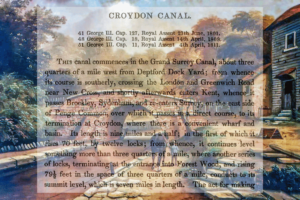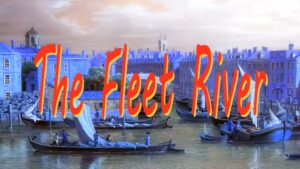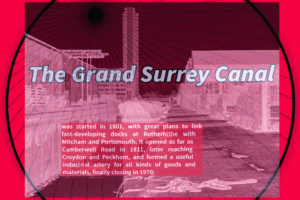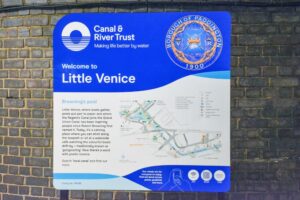A tour around Little Venice Part 2
Brownings Pool is the largest feature and it is the junction of three waterway routes. It is named after the poet Robert Browning, perhaps a gentrification in defiance of the older name used by the locals and boaters which was Rats Island, but also in recognition of Browning’s alleged naming of the area as the more iconic ‘Little Venice.’
The famous open area of water, often known as ‘Brownings Pool.’
There’s always boats in sight, but it wasn’t like that. The black and white picture from the 1960’s shows the pool area without a single boat to be seen! Admitedly it was winter but in time the pool became a popular winter mooring for many live-aboards.
Clicking this item from the Paddington Mercury, January 1985 (opens new window) shows a view of the pool with many 70 footers moored up during a freeze. At least two boats are recognisable in the news cutting’s picture – Lupin and Baltic, as well as Lady Rose of Regents and Water Buffalo. The miserable scrooges at British Waterways stopped these gatherings a couple of years later.
Waterside festivals have always been a feature of Little Venice, but they were actually more substantial, and rather more commercial, in the early days. Festivals have been held at Little Venice since the 1950’s following the saving of Beauchamp Lodge. The earliest festivals were run by the Paddington Institute but these were based on the roads and involved carnival processions, shows, and fireworks.
The very popular Boat Afloat Show, a 10 day event, was held here from the sixties until 1974. It celebrated the waterways and saw all shapes and sizes of craft, and there are countless photographs of speedboats ploughing their way across the pool. The very last show was opened by Arthur Lowe on May 23rd 1974. The reasons it was stopped were, according to British Waterways due to economic reasons, and its spokesman claimed that the show would be back.
The real reasons for its cessation were because it had become more and more commercialsed. Many local objections had been made, and the “prime objection to this show is that it appears to be on power boats and other noisy craft besides water ski-ing. These pastimes are not suitable for the canal.” (Local resident citing his views in the local papers) The Paddington Waterways Society’s chairman Colonel Flowers heralded the cancellation of the show as being “very good news.” (Information sourced from various local newspapers, including the Paddington Mercury during 1973 & 1975.)
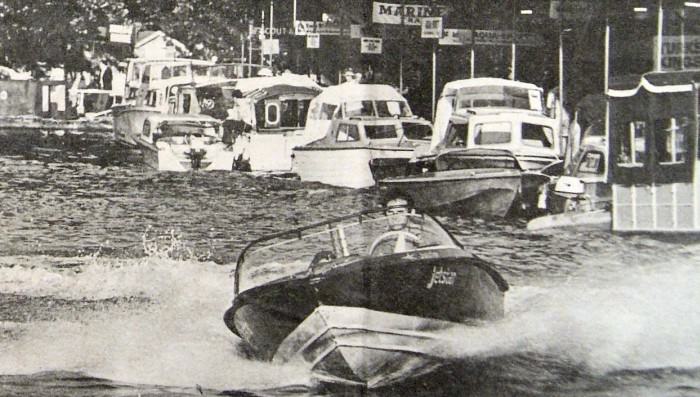
A speedboat crossing Brownings Pool during the 1970 Boat Afloat Show.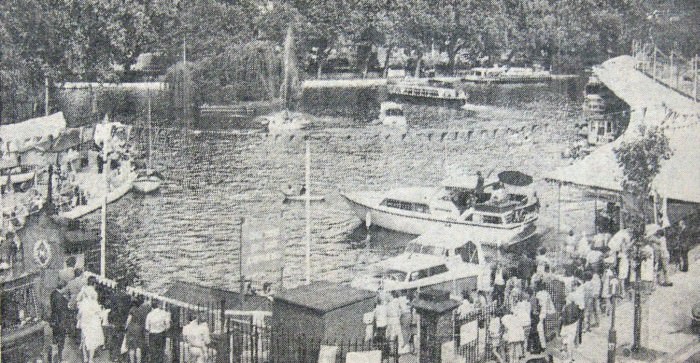
The final Boat Afloat Show in 1974.
Other festivals have taken place in the pool area over the years, the most notable being the Canalway Calvacade, which is held every year on the first May bank holiday weekend. A one off but extremely popular festival that preceded Canalways was the Easter Saturday rally of 1981 organised by CANAL (Campaign for Action on Navigation And Locks) which saw over 150 boats attending. The following year the Calvacade began.
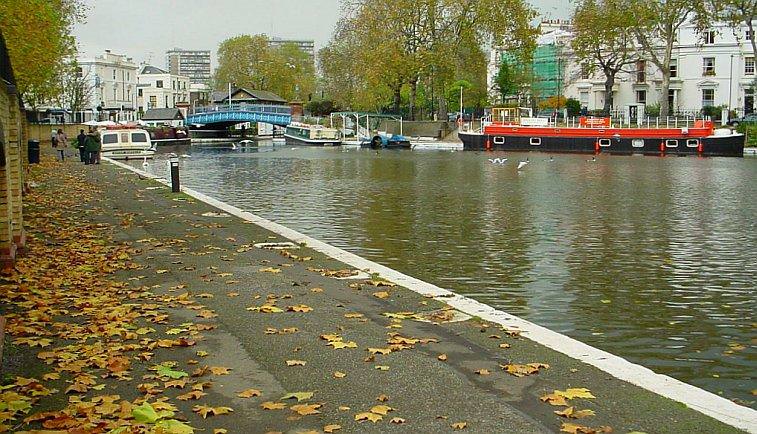
A more recent general view of the pool area in winter.
The pool area is the most well known part of Little Venice. The Floating Boater Cafe the London Waterbus Service to Camden, and Jason’s Trip are the main features of the pool area. The Cascade art gallery which was run for many years by Alex and Jan Prowse was taken over by new owners around 2007, but it appears that the enthusiasm to continune the floating art gallery has faltered somewhat.
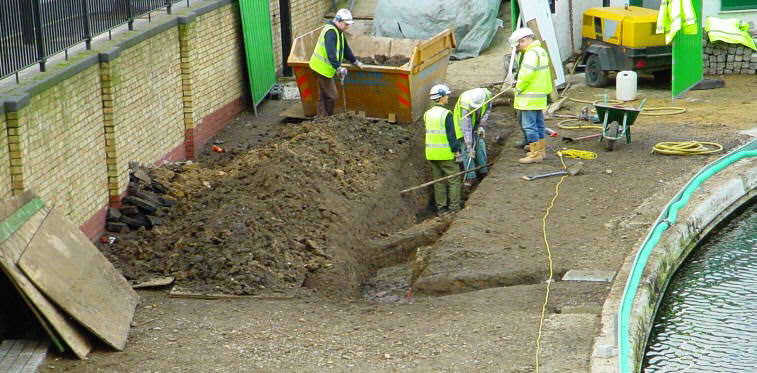
Like so much of London’s canal system, water space here has been stealthily reduced. The Little Venice pool used to be larger. Excavations in 2004 showed part of the much older brick wall (in trench, centre of picture) that once lined the basin. Paddington Basin is just round the corner and that too has suffered a substantial amount of reduction in its waterspace.
Rembrandt Gardens
The Gardens were opened in the early 1950’s. The original name was Warwick Avenue Gardens. It was built upon the site of some Italinate houses. The name was changed in 1975 when the City of Westminster was presented tulips by the City of Amsterdam. An opening ceremony was held with the Dutch in full national dress to celebrate the new links between the two cities and the place became rembrandt gardens in honour of one of Hollands finest painters. For the opening ceremony and some time after the gardens had a direct footbridge connection across the canal to the towpath on the Blomfield Road side of the Little Venice Pool.
Rembrandt Gardens forms a tranquil area of rest and relaxation whilst being able to watch the boats go by. The gardens also have accessible toilets.
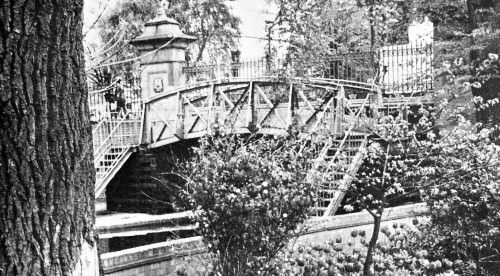
There used to be a footbridge from the north side of the pool to Rembrandt Gardens. This is one of a couple of pics I’ve managed to find.
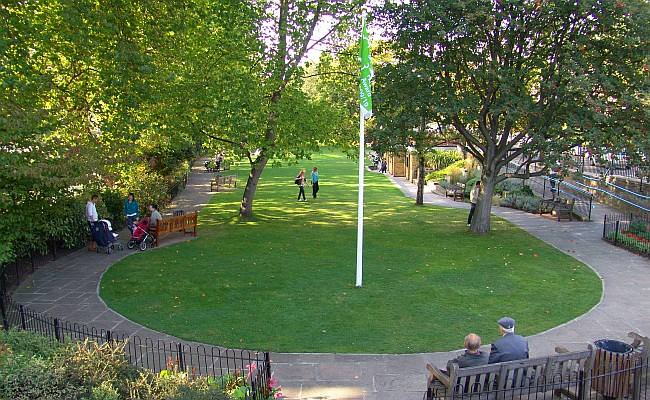
Rembrandt Gardens.
The ‘Arklight’ Project
Next is the stretch marking the start of the Regents Canal towards Maida Hill tunnel. The Toll House here has some similarities to the one on the other side of the pool, but was smaller, given the more constrained land available here at the time of construction. Blomfield Road never had any moored boats right up until the 1970’s. The only reason they appeared here was because the British Waterways Board (BWB) moved them here! This was done in order to make way for a fleet of illuminated boats that were to based at Cumberland Basin. The controversial ‘Arklight’ project is discussed elsewhere on the London Canals pages. Suffice to say the proposals were objected to vigorously but the displaced boats did not return to their old moorings.

A poor picture of Warwick Avenue bridge. The ‘beaches’ reflects the poor state of towpath then, but it is obvious there was far more water space too!

Maida Hill West at the turn of the centuries. The middle house in view belonged to Dave Gilmour of Pink Floyd. He sold it to Earl Spencer, who wasn’t very popular with the neighbours!
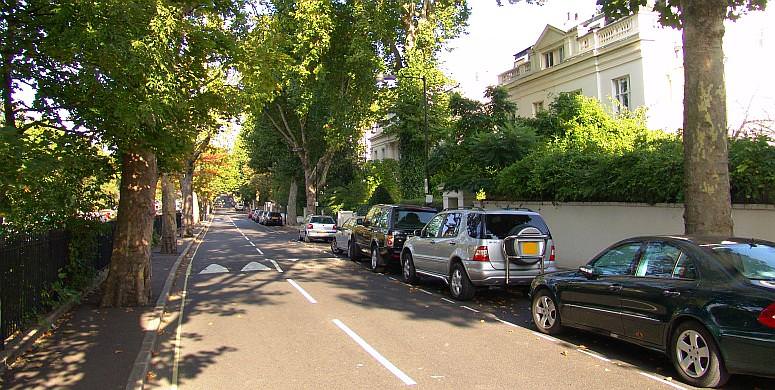
The same scene today at Maida Hill West – well not quite! Taken about 15 yards east of the original. Trees obscure any good views of both avenue & houses.
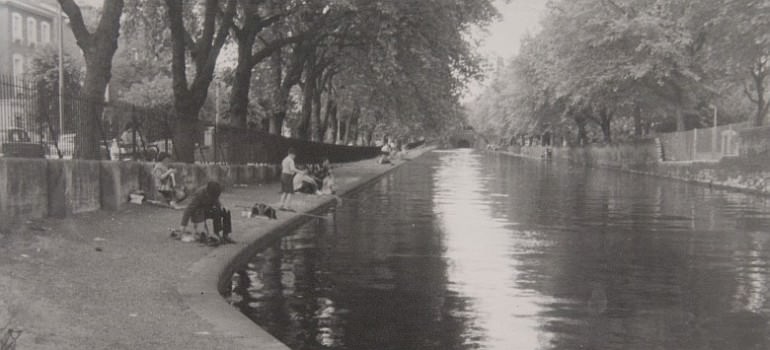
The Blomfield Road stretch looking towards Maida Hill tunnel in the 1940’s. Its clear the canal was popular for fishing!
Many views from this period show the true attractiveness of this stretch, with absolutely no moored boats at all in sight. It is clear that it was the wide expanses of water that helped to gain the area’s recognition as Little Venice. It was NOT the hordes of boats that are now moored along this stretch! The above view shows just how much has been lost in terms of the area’s dramatic waterscape.

The original Jasons Trip at Blomfield Road in the first year of working. This is not the same as the Jason that now operates the trips.

Blomfield Road – the site where the original Jasons (and Lord St Davids’) boats worked from. This is about 100 metres west of the junction with Edgware Road. Some will recognise this picture as being one of those many days of diversions on both bus routes 6 and 98 in their last months of Routemaster operation.
Below: Trip times and fares in 1952, and a leaflet for 1964 which shows the trips were still operating from the old location. This must have been confusing for visitors of the time. The leaflet tells us the embarkation point was opposite No. 60 Blomfield Road. But that was actually where Jason had moved to so the photograph was an old one used on the leaflet! The original embarkation point was roughly opposite the junction of Blomfield Road and Randolph Avenue, roughly 100m from the Edgware Road (as seen in the picture with the buses.)
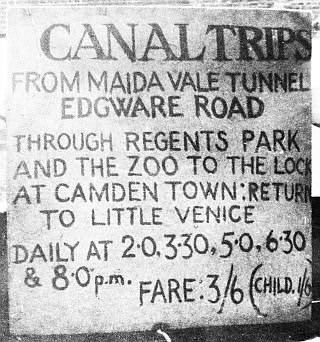
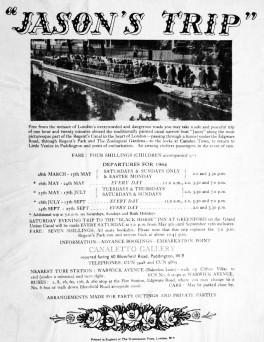
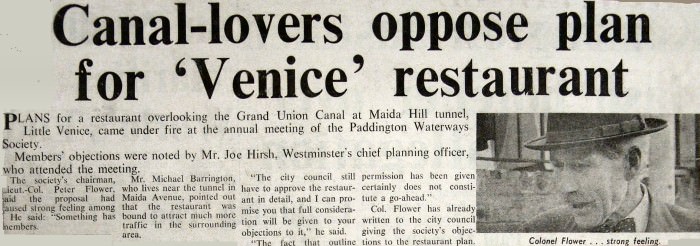
At the far end of Blomfiled Road is the Maida Hill tunnel and Cafe Laville. The cafe offers splendid views along Blomfield Road. But it wasnt always wanted as the news article extract shown above explains. In fact it was claimed that locals had accepted the plans in 1970, but when they were resubmitted in 1973, vigorous opposition was met. It seems some of the opposition came form the fact that there was a cafe at this location already, on the corner opposite the tunnel entrance at 451 Edgware Road. This was the , an Italian style restaurant owned by Piero Peirone. The new cafe was eventually approved, and opened in 1974. The Canaletto has long since gone and the Hsing, a Chinese restaurant is now in its place.
We now come to the end of the Blomfield Road section, and this is where the Maida Hill tunnel begins. For more on this see the London Tunnels section. Here’s a look at the Maida Hill tunnel portal as it was in 1815, in what can only be described as countryside, with a country house on the corner at what is now the Hsing restaurant on Edgware Road. It appears from old maps that the house seen in the picture was known as Hill House. The trees would have been the southernmost extent of the former St John’s Wood. The woods no longer exist – except as a name!
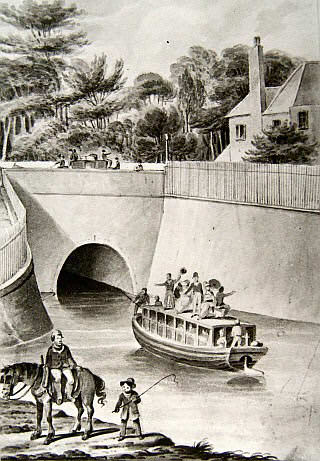
On the area adjacent to the Maida Hill tunnel where Hill House once stood, was the popular Canaletto restaurant. It was linked to the canal and featured works of art on the waterway. The gallery eventually moved afloat. The venue is now the Hsing, a Chinese restaurant, as mentioned previously.
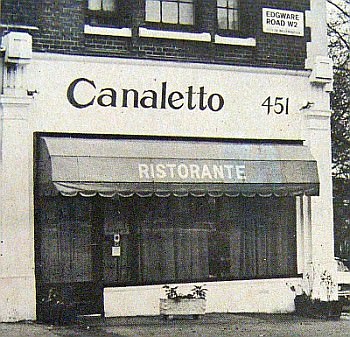
The Canaletto at 451 Edgware Rd, now the Chinese restaurant Hsing.
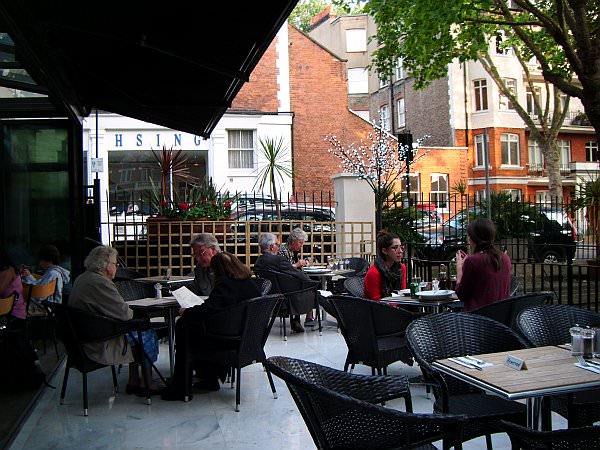
The other popular venue is of course the Cafe Ville with its dramatic outlook perched on top of the tunnel’s portal. Cafe Ville’s dramatic platform over the entrance to the Maida Hill tunnel was opened in June 2011 – and now provides more space for its customers to enjoy the spectacle looking down Blomfield Road – as shown above. The Hsing can be seen in the background.
Next: Little Venice part 3
